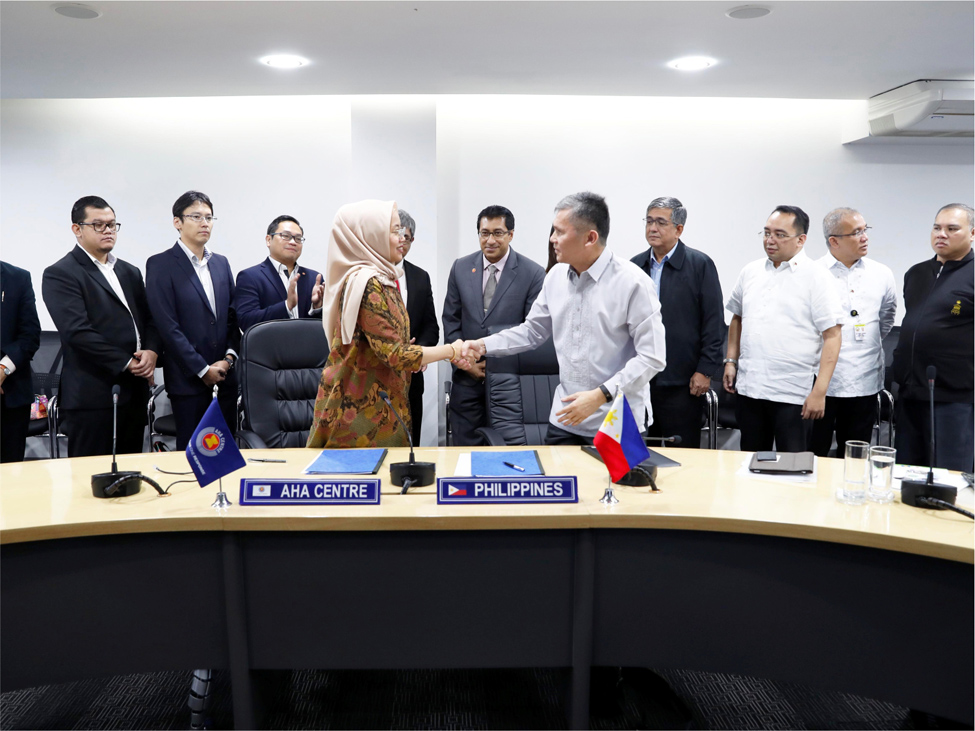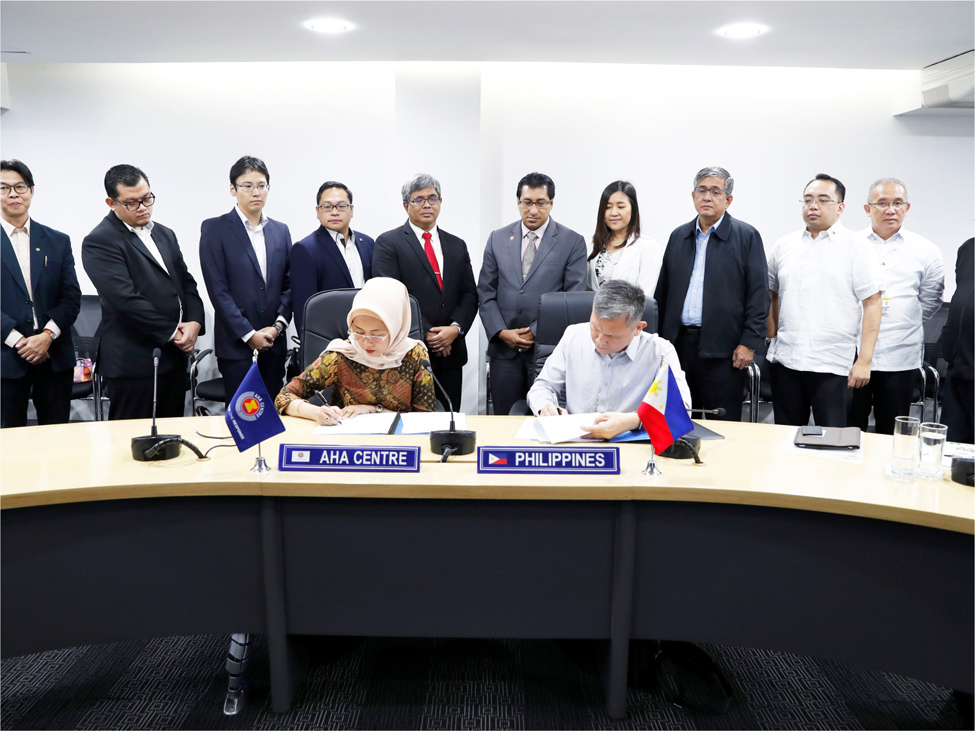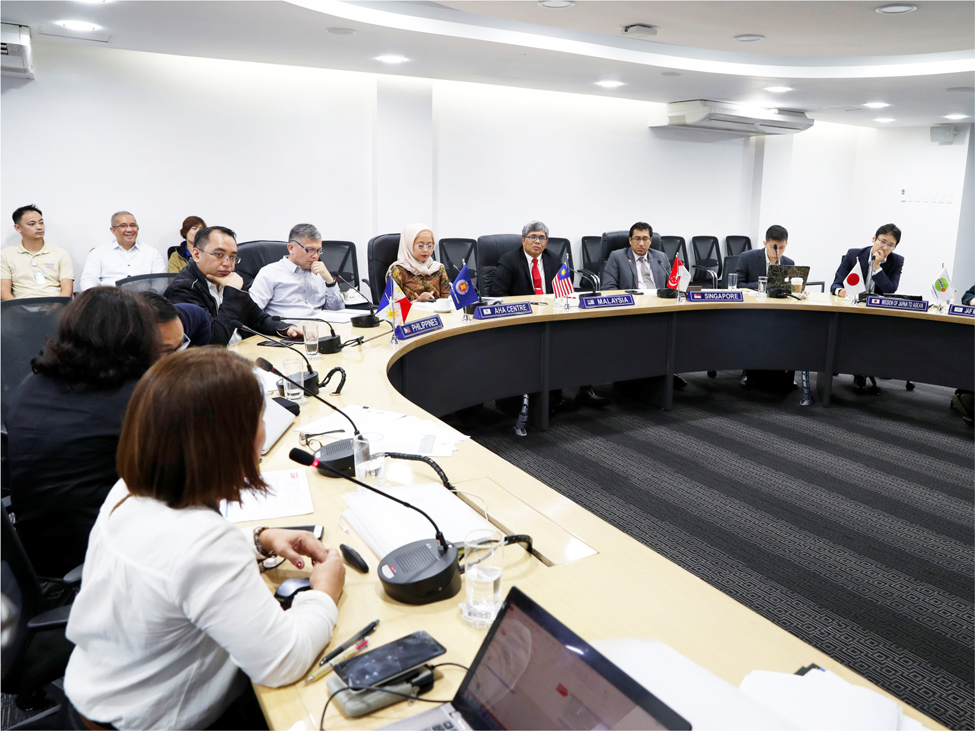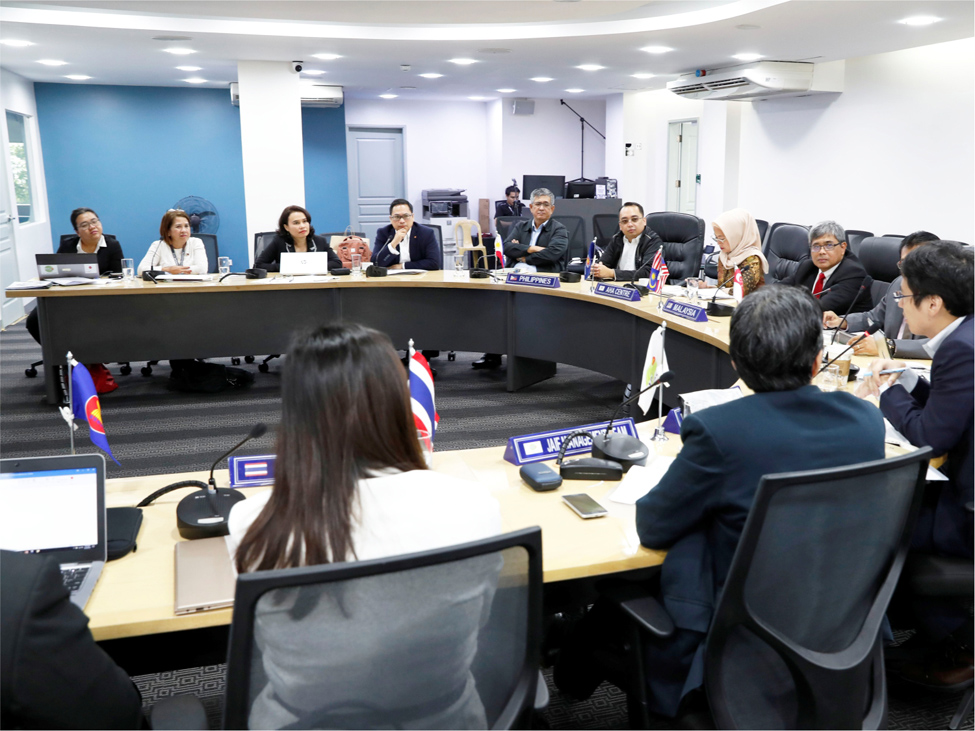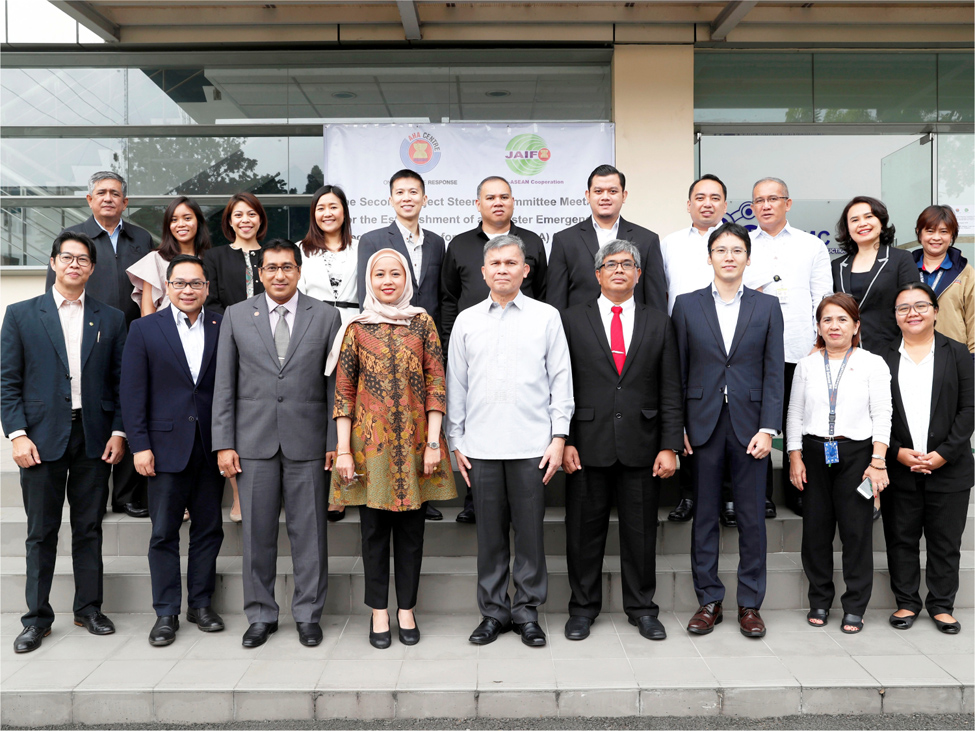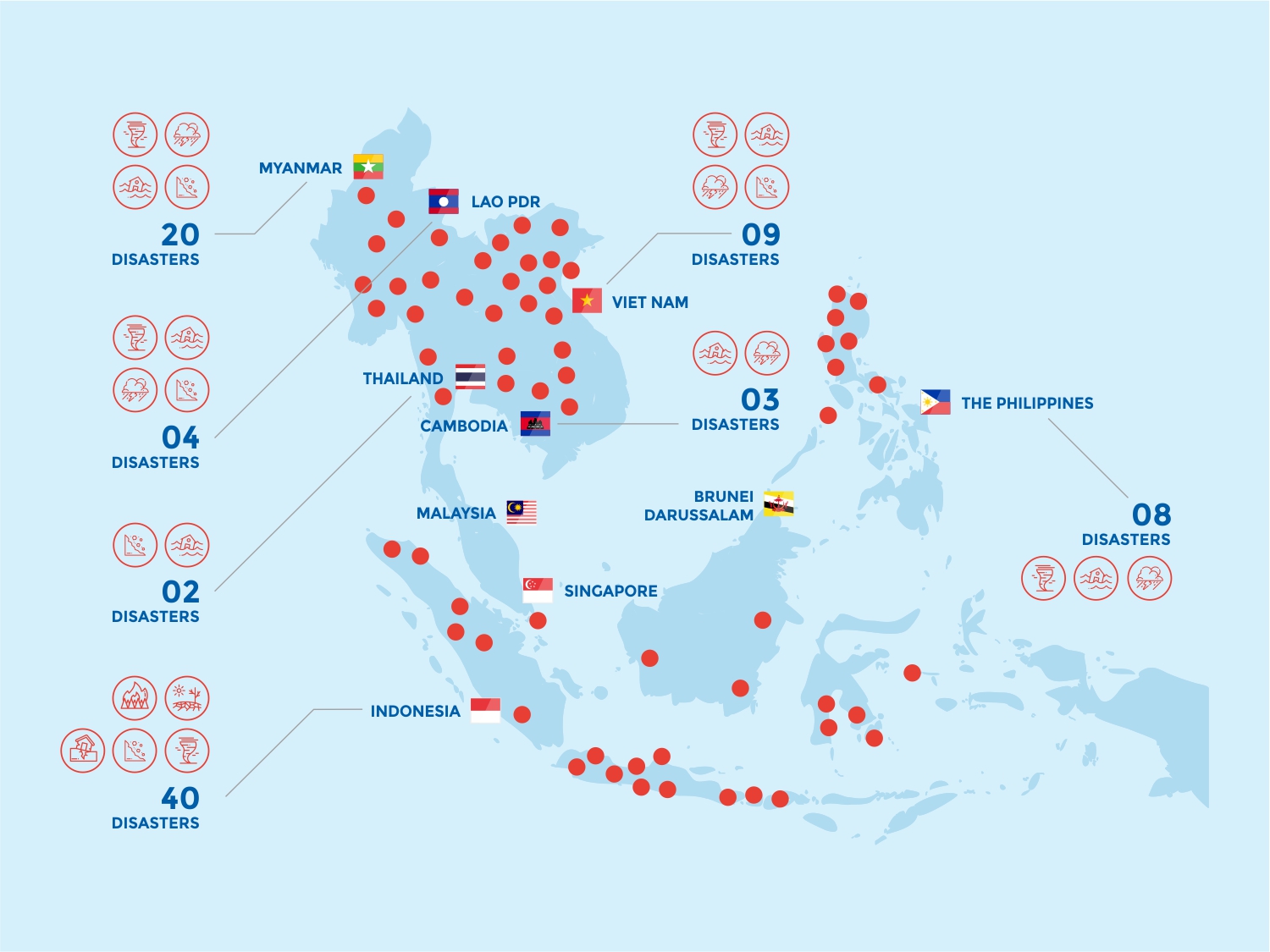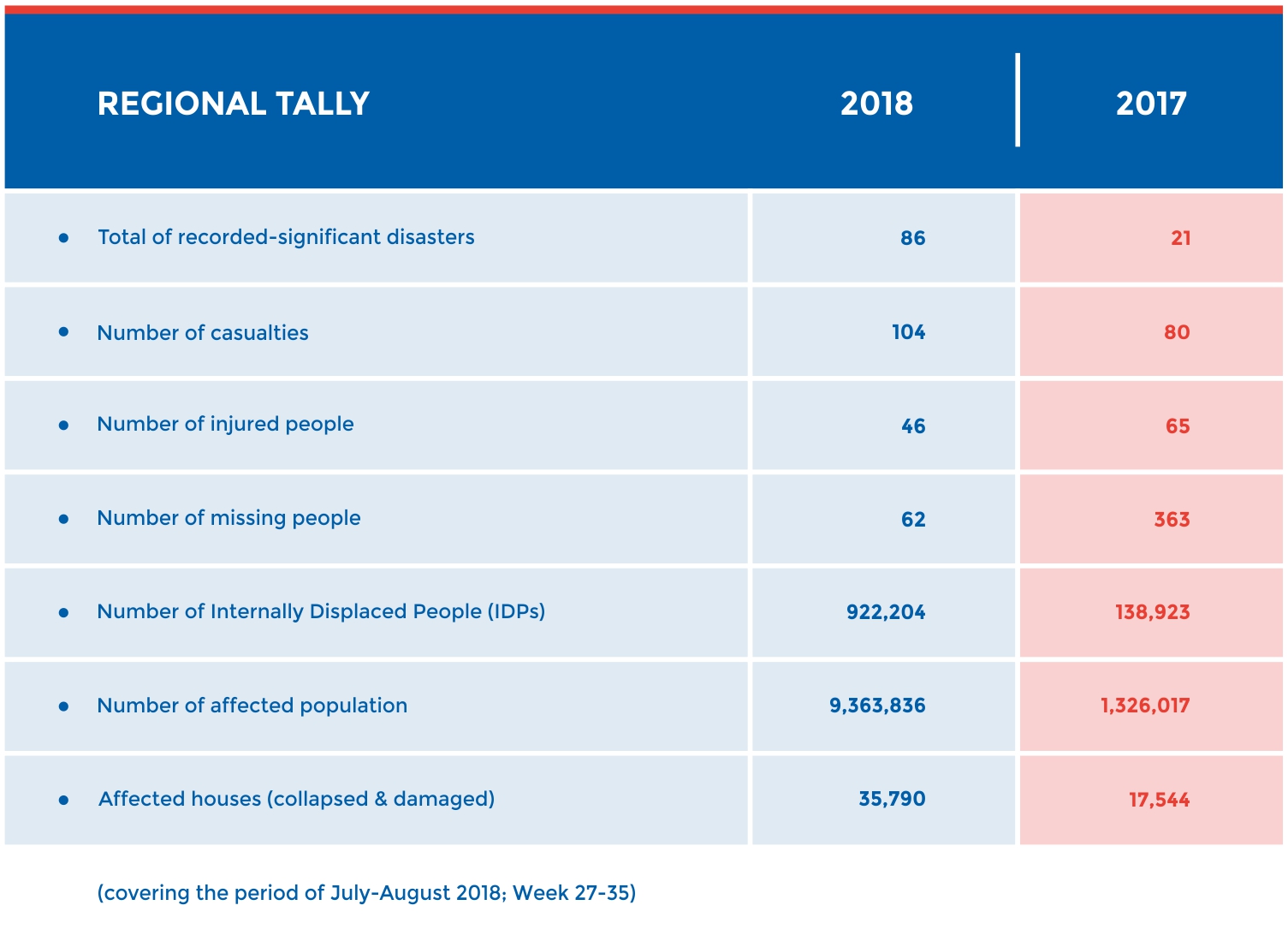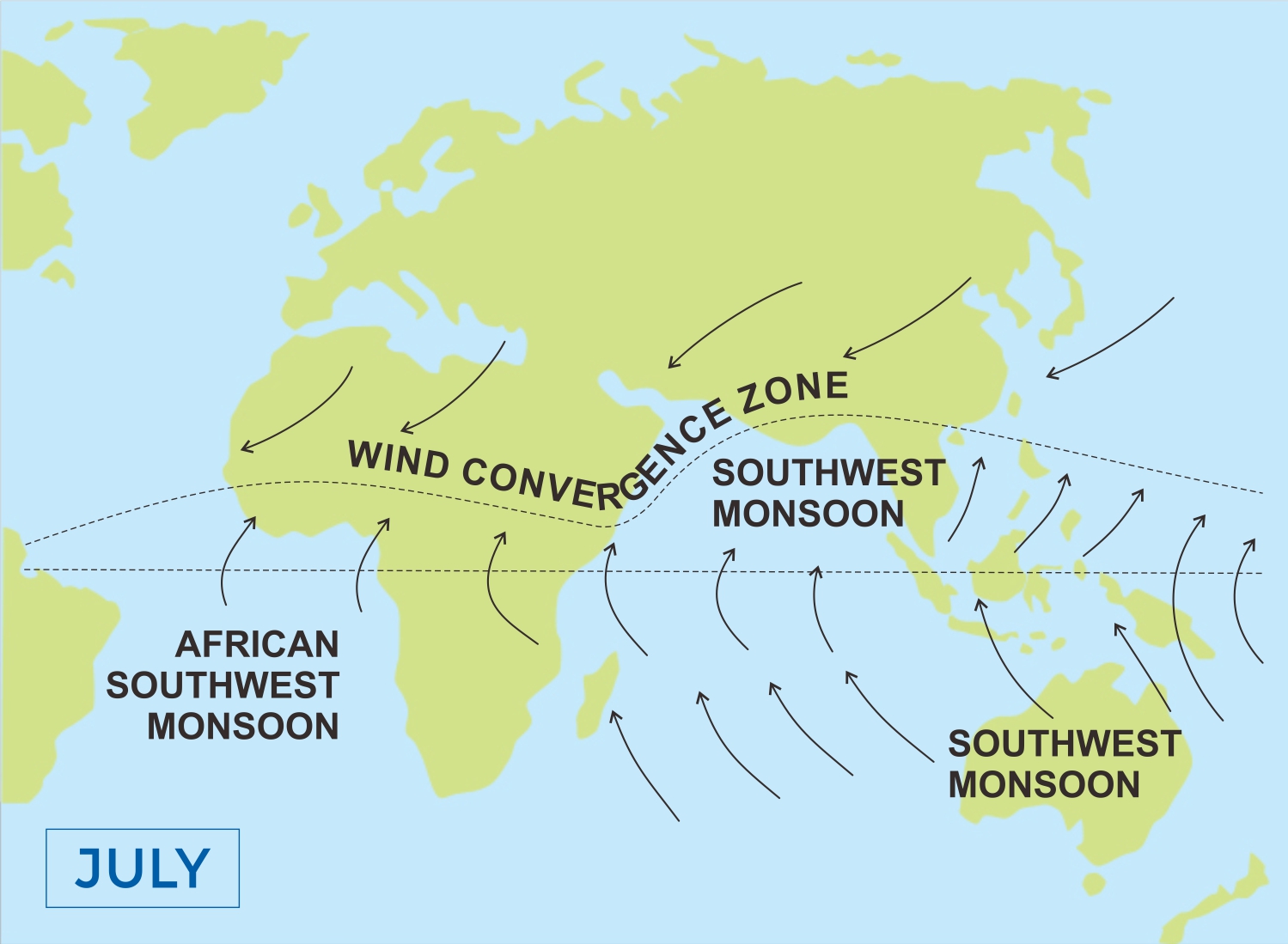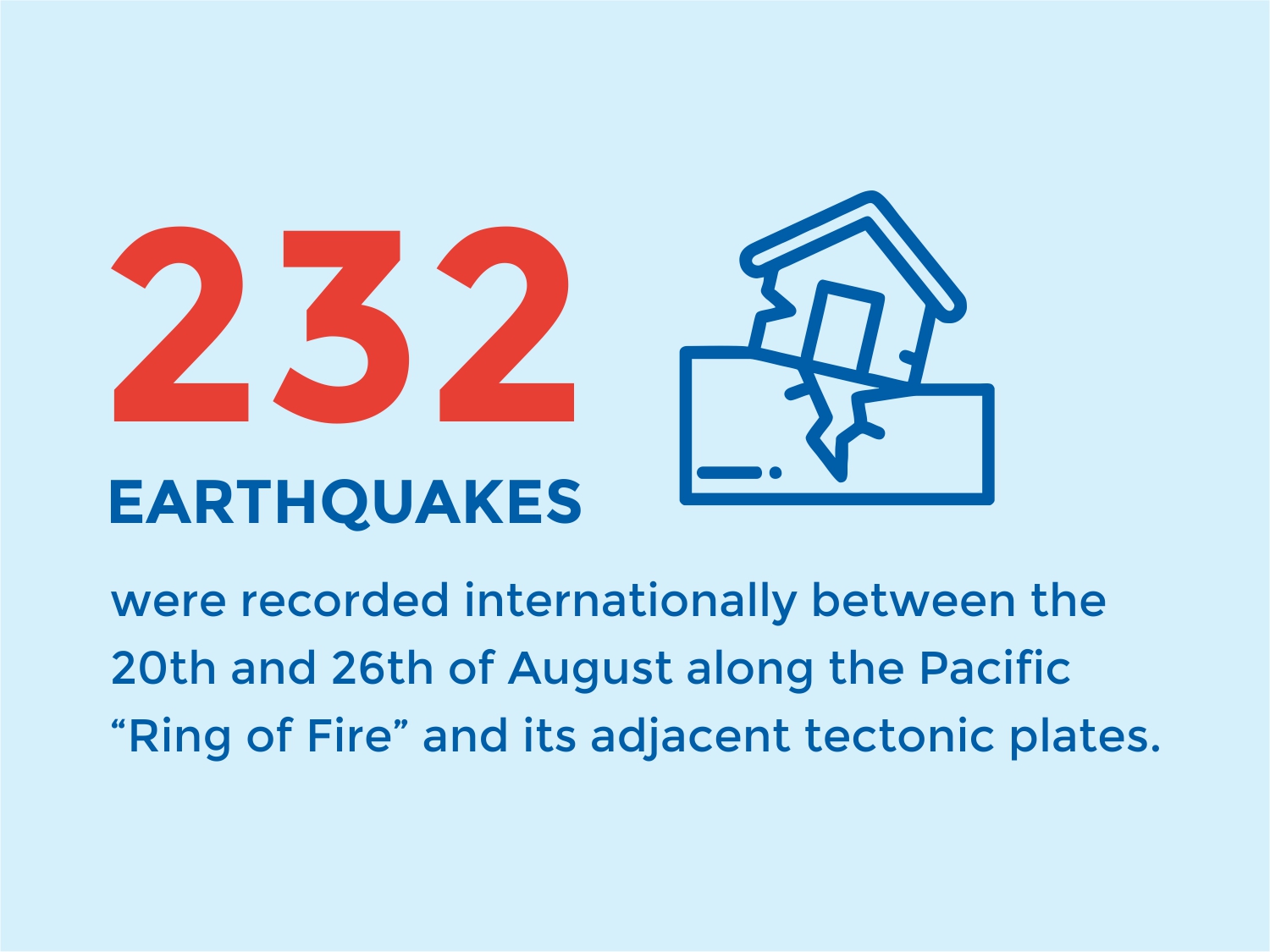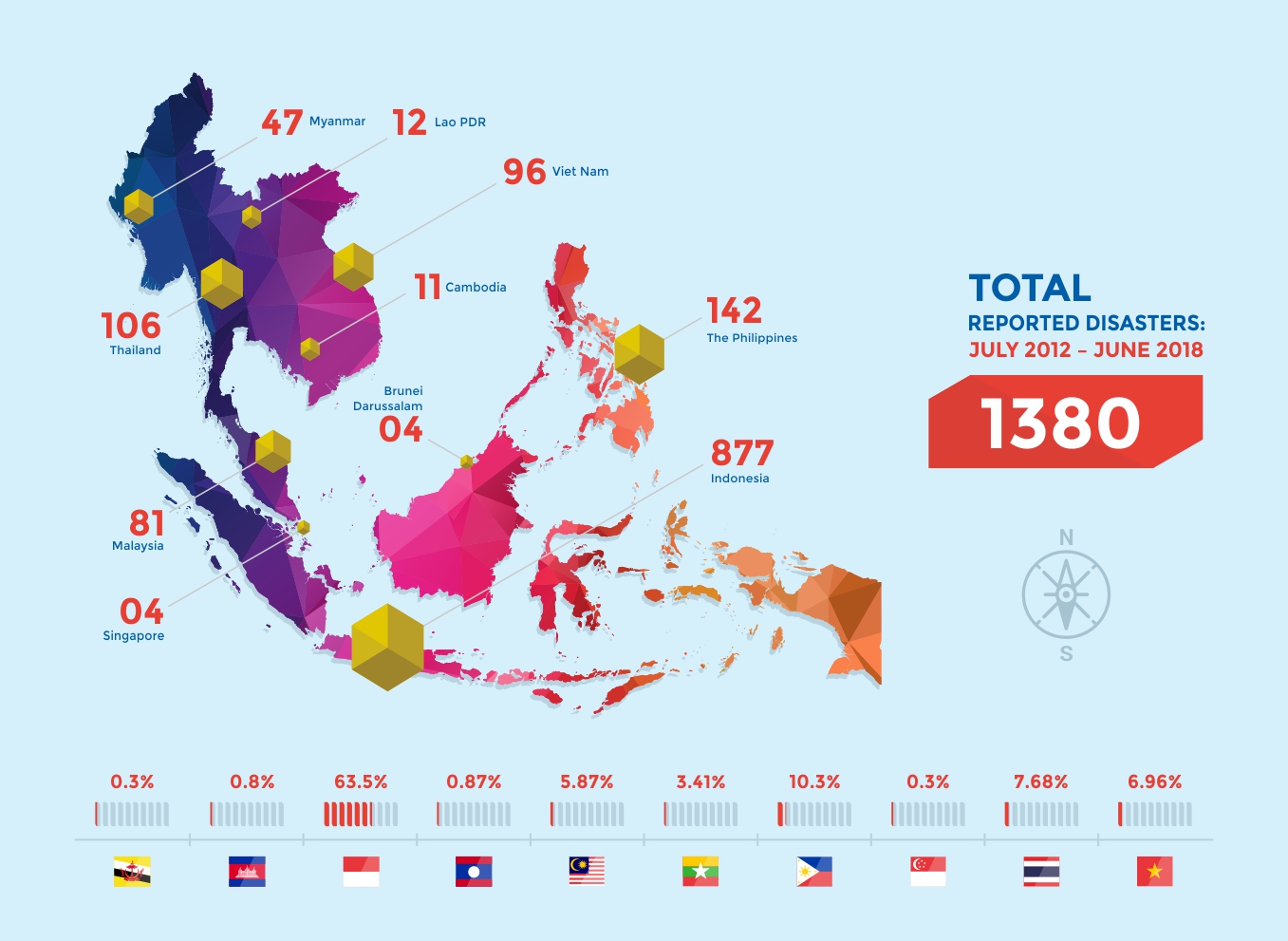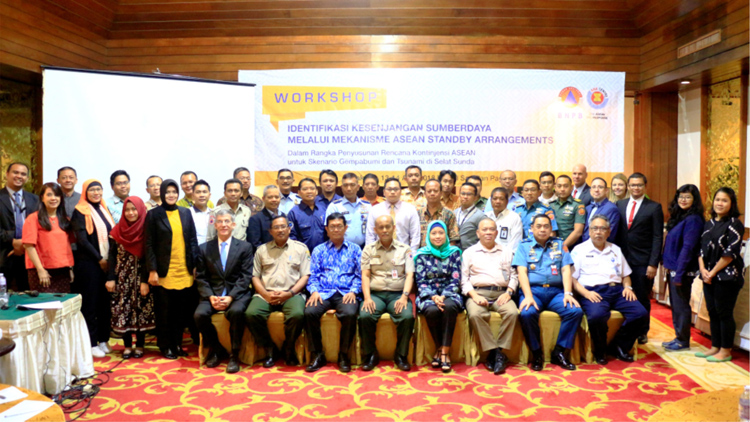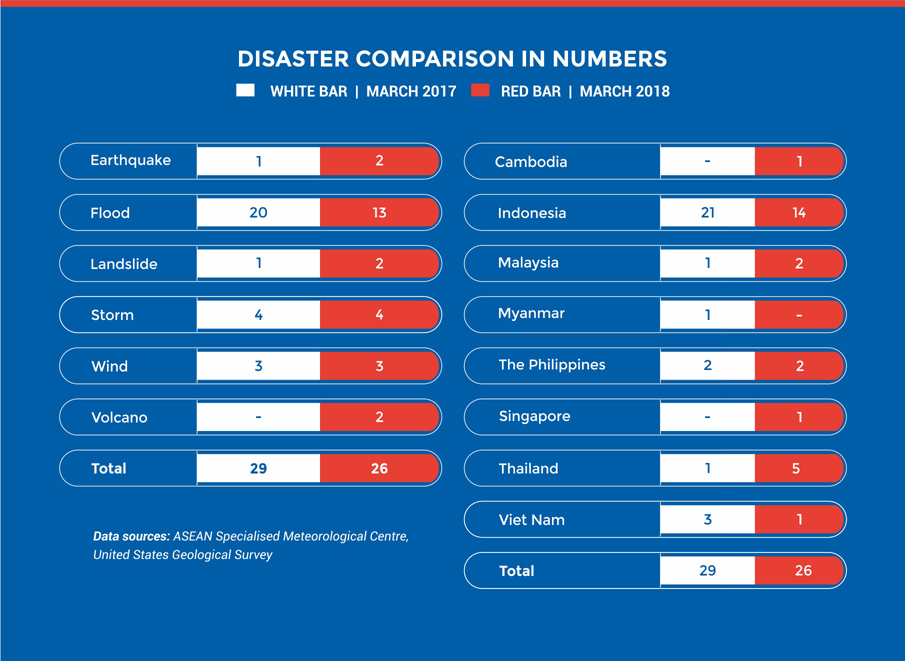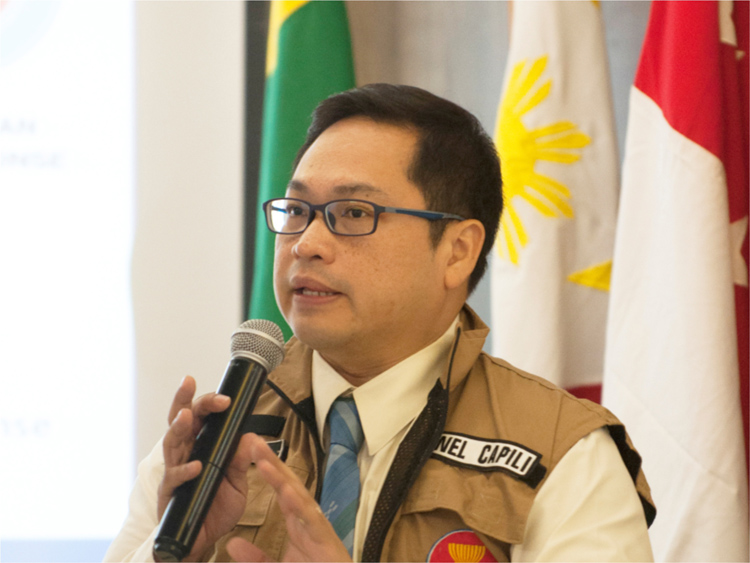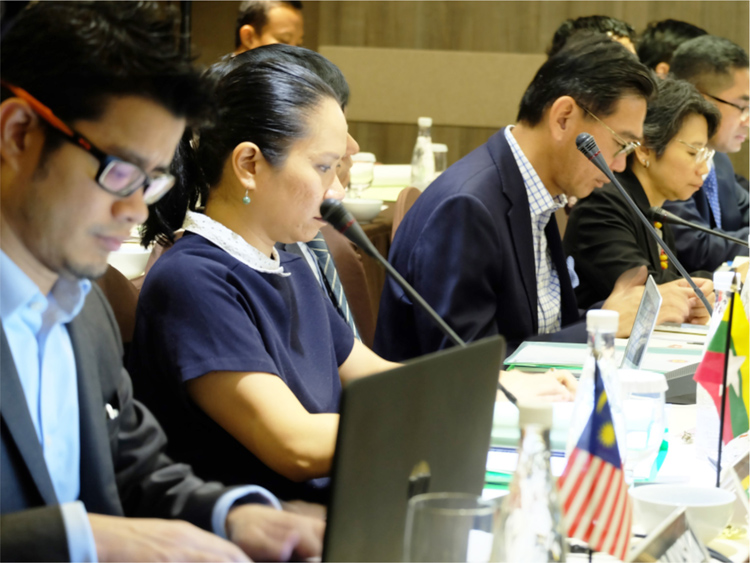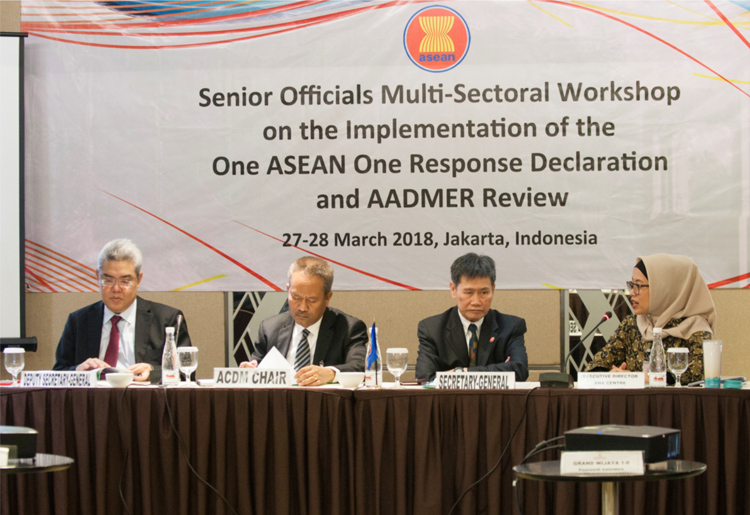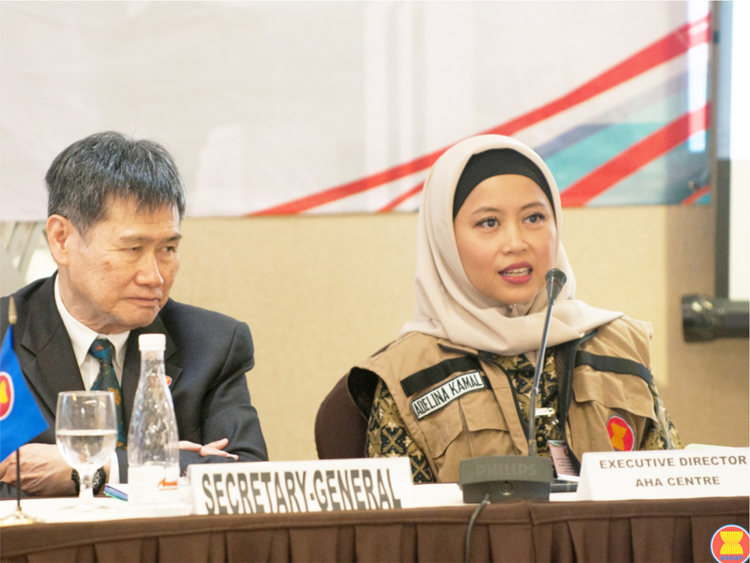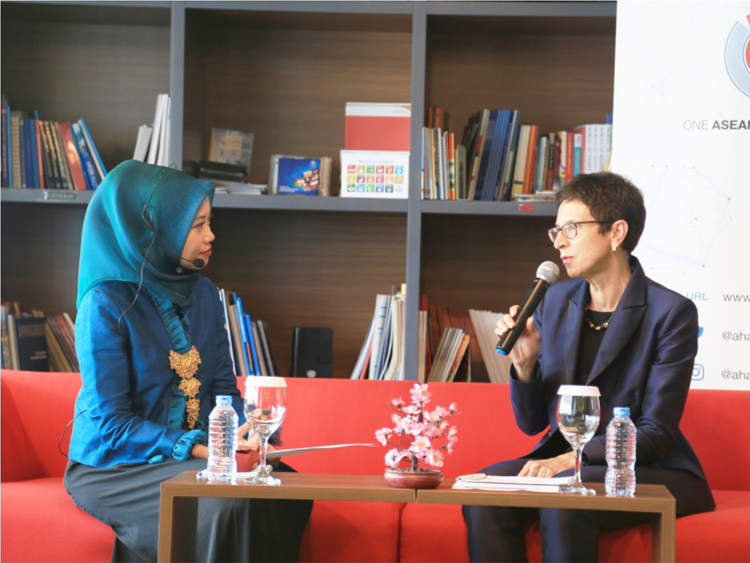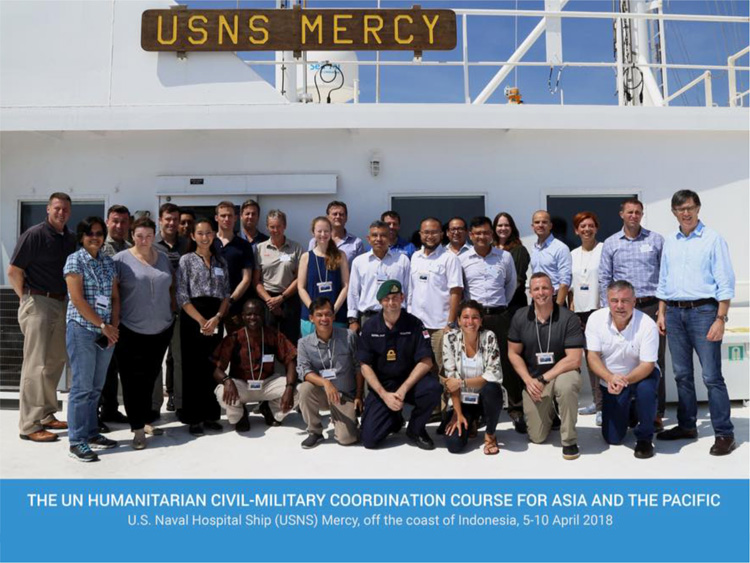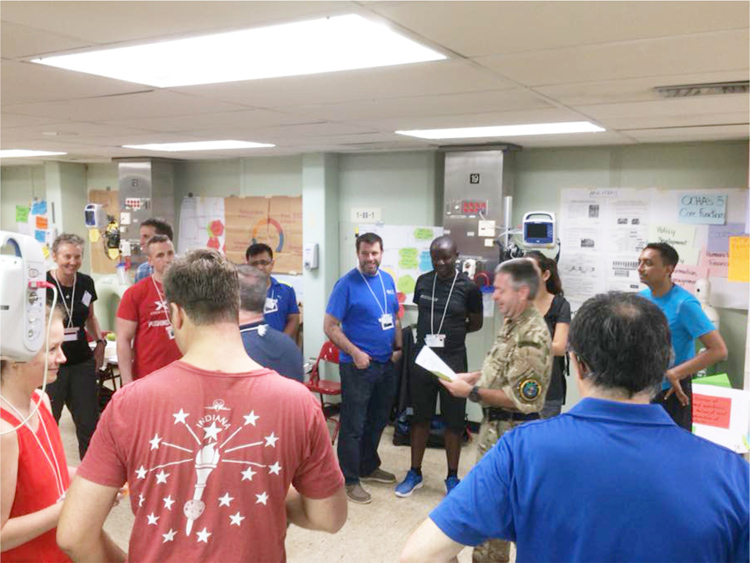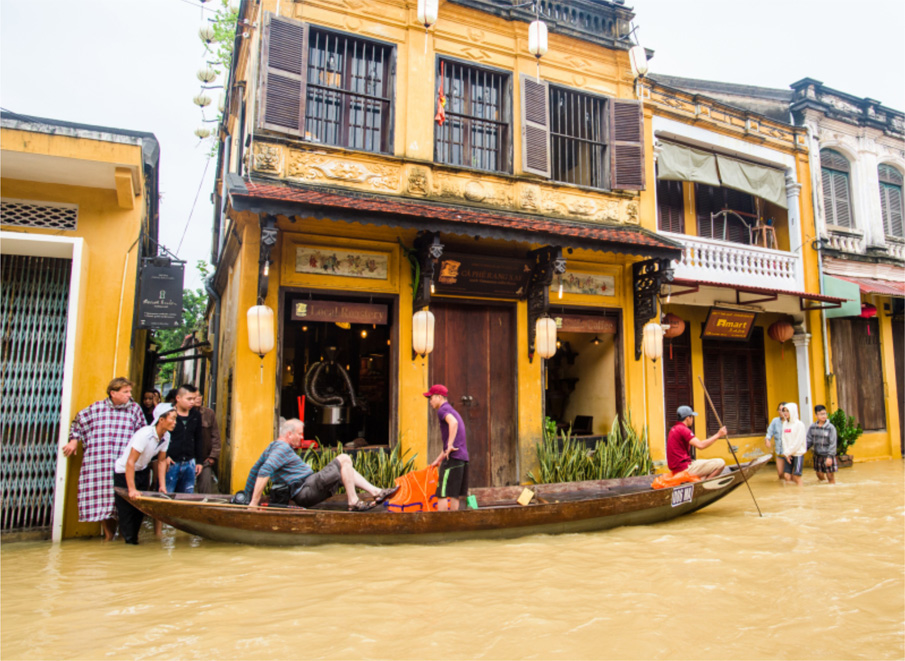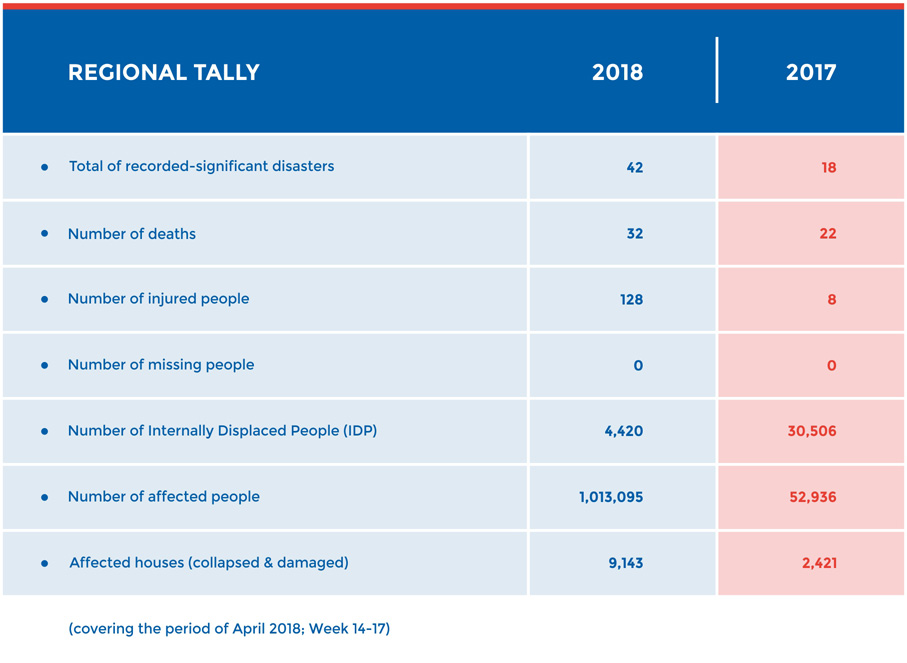Vol 42-DELSA II Project Steering Committee Meeting

DELSA II
PROJECT STEERING COMMITTEE MEETING
MANILA, THE PHILIPPINES, 24TH AUGUST 2018
Entering its second phase of implementation, the Disaster Emergency Logistics System for ASEAN (DELSA) Phase II project continues to contribute to the implementation of One ASEAN One Response, specifically in the area of stockpile deployment to disaster-affected countries. As the leading mechanism in the Phase II project, the DELSA Phase II Project Steering Committee (PSC) meeting was held on the 24th of August in the OCD-NDRRMC Office, Camp Aguinaldo, the Philippines.
As reported in the meeting, during 2018 the DELSA Phase II project has contributed to stockpile deployment and local procurement in response to the floods in Lao PDR, floods in Myanmar, and the earthquakes in Indonesia, providing relief items to a total value of USD 426,867. The remaining ASEAN stockpile, which is stored in the UN Humanitarian Response Depot in Subang, Malaysia, consists of 45 types of relief items amounting to the total value of USD 1,777,460.
This meeting also formed an opportunity for the DELSA Project Management Team to report the progress of the establishment of the satellite warehouses in the Philippines and Thailand. The satellite warehouse in the Philippines utilises a building owned by the Armed Forces of the Philippines in Camp Aguinaldo, which after some renovations, will be ready to house the satellite warehouse.
Meanwhile, the satellite warehouse in Thailand is planned to be fully operationalised by the first quarter of 2019, with a scheduled official launching during the ASEAN Summit in April 2019, coinciding with the induction of the Thailand Chairmanship of ASEAN.
A Memorandum of Understanding (MoU) for the establishment of the satellite warehouse in the Philippines was also signed during the meeting by Ms. Adelina Kamal, Executive Director of the AHA Centre, and Under Secretary Ricardo B. Jalad, Executive Director of NDRRMC and Administrator of the OCD Philippines. This MoU marks the strengthening of cooperation and commitment between the AHA Centre and OCD Philippines to support the readiness of ASEAN in responding to disasters. The meeting also resulted in other significant guidance and decisions on key resources, criteria and partnerships to support the network of the DELSA warehouses. A key study on stockpile identification was agreed, with results to act as a baseline that will serve as a reference for minimum types and quantity of stockpiles to be stored across all three DELSA warehouses, as well as specific stockpiles unique to each warehouse.
The DELSA Phase II PSC Meeting was attended by the AHA Centre, ASEAN Secretariat, representatives from Singapore and Malaysia as the Co-Chairs of the ACDM Working Group on Preparedness and Response, representatives from the Mission of Japan to ASEAN and Japan-ASEAN Integration Fund (JAIF) Management Team as the donor, and representatives from the Philippines and Thailand as the host countries of satellite warehouses.
Written by : Caroline Widagdo | Photo : AHA Centre
- Published in AHA Centre Diary 3
Vol 42-Monthly Disaster Review and Outlook

MONTHLY DISASTER REVIEW AND OUTLOOK
JULY & AUGUST | DISASTER MONITORING & ANALYSIS
(DMA) UNIT, AHA CENTRE
GENERAL OVERVIEW OF JULY AND AUGUST 2018
A two-week period in July saw the development of 5 tropical storms, one of which had a severe affect on the northern ASEAN region. The Southwest monsoon (refer to figure 1.) brought with it heavy torrential rains, resulting in flooding through the Mekong River region. Hydro-meteorological disasters formed the main hazards during this period, and are expected to persist with continued rain over the northern ASEAN region, coupled with drier conditions in southern part of ASEAN.
In contrast to the situation in the northern ASEAN region, droughts in 16 municipalities have been reported across seven consecutive weeks thus far, with one reported wildfire occurrence in the past month. The ASEAN Specialised Meteorological Centre detected hotspots in Indonesia’s Kalimantan and Sumatra during July. General conditions for August remained similar to July, with high rainfall experienced over the northern region, impacting countries in the Mekong region and northern parts of the Philippines.
Throughout the last 2 months, large numbers of earthquakes were recorded and experienced by ASEAN communities. The increased seismic activity is not only restricted to the region,with the phenomenon also seen globally. A total of 232 earthquakes were recorded internationally between the 20th and 26th of August along the Pacific “Ring of Fire” and its adjacent tectonic plates. Of these recorded earthquakes, 37 (15.9%) were recorded at a scale of M 5.0 or above, with 25 (67.6%) of these major earthquakes (≥M 5.0) occurring within a span of 48 hours between August 20th to 22nd. Of these 232 earthquakes, 32 (13.8%) were reported within the ASEAN region. Of the 32 recorded in the region, 11 (34.4%) were reported to be M 5.0 and above. The increasing seismic activity is currently being observed by seismological agencies in anticipation of increased volcanic activity, earthquakes, tsunamis and other related hazards. Nevertheless, in July and August 2018, activity of volcanoes in Philippines and Indonesia stayed within their normal threshold, with no changes in any of their alert levels
The prevailing Southwest Monsoon season is expected to persist until October 2018, with prevailing winds in the region blowing from the southeast or southwest. Climatologically, the Southwest Monsoon season is characterised by rainy conditions in the northern ASEAN region, and dry conditions in the southern ASEAN region.
OUTLOOK FOR AUGUST-OCTOBER 2018
Warmer than average conditions can be expected over the equatorial ASEAN region, especially in Borneo and south-eastern Sumatra, while near-average or slightly above-average temperatures are forecasted over most other areas during the August-October season.
For the equatorial ASEAN region, below-average rainfall is forecasted between August and October. The drier-than-usual weather could to lead to an escalation in hotspot activities and an increased risk of transboundary smoke haze.
Near-average rainfall is forecasted for the rest of the region, including the northern ASEAN region. Hotspot activities in the northern ASEAN region are likely to remain subdued due to wet weather. The outlook is assessed for the region in general. For specific updates on the national scale, the relevant National Meteorological and Hydrological Services as well as Geological Services should be consulted.
Written by : Mizan Bisri, Qing Yuan Pang
DISCLAIMER
AHA Centre’s estimation is based on data and information shared by National Disaster Management Organisations (NDMOs) and other relevant agencies from ASEAN Member States, international organisations and news agencies. Further information on each recorded-significant disaster, description and details of data and information are available at: http://adinet.ahacentre.org/reports.
- Published in Monthly Disaster Outlook
Vol 40-Total Reported Natural Disaster in Southeast Asia

TOTAL REPORTED
NATURAL DISASTERS IN SOUTHEAST ASIA
JULY 2012 – JUNE 2018
The AHA Centre has been monitoring disasters across ASEAN since its establishment in 2011. This month, we present a snapshot from consolidated data of recorded disasters that have taken place in the ASEAN region throughout the past six years.
As can be seen, the occurrence of disaster in Indonesia is extremely high, due much to its location on the ‘Ring of Fire’ – with its high tectonic activity – resulting in ongoing threats from earthquakes and volcanoes, alongside hydro-meteorological events such as flooding and landslides. Nations such as Malaysia, the Philippines, Thailand and Viet Nam have also experienced high numbers of disasters, often as a result of monsoonal seasons and heavy rainfall. Even for nations with lower numbers, the risk of disaster remains high. Due to ongoing optimisation of AHA Centre’s monitoring systems, as well as improving regional disaster classifications and reporting mechanisms, localised disasters may have previously been under-reported, with numbers for many nations potentially higher than displayed above. This highlights the importance of the AHA Centre’s existence, to support the skills development and increase capacity of Member States to prepare, monitor and respond to disasters of all varieties and at a world-class level.
Written by : Shintya Kurniawan, William Shea
DISCLAIMER
The presented information above is consolidated from the ASEAN Disaster Information Net (ADINet) and the Emergency Events Database (EM-DAT).
- Published in Insight
Vol 37-Contingency Planning Workshop

CONTINGENCY
PLANNING WORKSHOP
JAKARTA, 13-14 MARCH 2018
In Jakarta on 13-14 March 2018, the AHA Centre engaged about 50 participants in a two-day ASEAN Contingency Planning workshop for Indonesia. Participants came from different Indonesian line ministries involved in disaster response and disaster management, including the National Disaster Management Authority (BNPB), the Local Disaster Management Agency (BPBD), the Meteorology, Climatology, and Geophysics Body (BMKG), the Department of Defence, the army, the Transportation Department, and the Ministry of Health.
Using a scenario of a large tsunami hitting the industrial city of Cilegon, the participants managed to identify at least 31 items, consisting of assets and capacities, that were categorised as immediate needs by the affected population. Included in the identified items are medicine, emergency medical teams, urban search and rescue teams, water treatment facility, and the needs of vulnerable groups: nutritious food for infants, breastfeeding mothers, and aid for people with disabilities. The workshop also stimulated discussions on transportation and logistics access, that would serve to enable timely distribution of humanitarian assistance from ASEAN Member States and partners.
The workshop is part of the AHA Centre’s effort to continue the development of the ASEAN Joint Disaster Response Plan (AJDRP). The AJDRP has identified three major disaster risks in the region–a major earthquake in Metro Manila, a super cyclone in the Ayeyarwady Delta in Myanmar, and tsunami caused by a megathrust earthquake in Indonesia. Three workshops, with Jakarta being the final, have now been undertaken using these scenarios, in order to enhance the speed, scale, and solidarity of ASEAN’s collective response to major disasters in the region. Similar workshops have been conducted in Manila, the Philippines, and Nay Pyi Taw in Myanmar in 2017.
With the conclusion of the workshop in Jakarta, the AHA Centre is now able to identify common needs in large-scale disasters, and consider how ASEAN can support the affected Member State(s) at such a time. However, it is important to highlight that any disaster response operation should always be nationally led, regionally supported, and internationally reinforced as and when necessary.
Arnel Capili, the Director of Operations of the AHA Centre, noted that ASEAN can only engage effectively if a relationship of trust has been developed within all the Member States. “We can only operate on the speed of trust”, he remarked, “which is why it is important to continue the dialogue, to build on what we already have, and move forward from there.”
Written by : Shintya Kurniawan | Photo : BNPB
- Published in AHA Centre Diary 1
Vol 37-Monthly Disaster Outlook

MONTHLY DISASTER REVIEW OUTLOOK
MARCH 2018 | DISASTER MONITORING & ANALYSIS
(DMA) UNIT, AHA CENTRE
GENERAL OVERVIEW OF MARCH 2018
Hydro-meteorological disasters, particularly floods, strong winds and storms, continued to dominate disaster occurrence figures in March 2018. During the month, flash-flooding events due to extreme rainfall within a short amount of time, occasionally triggering landslides as a secondary disaster, as evident in several events across Indonesia. Localised strong winds and storms caused damage in Cambodia, Singapore, Thailand and Viet Nam.
In terms of geological hazards, moderate-to-strong earthquakes (≥ M 5.0) were observed in Indonesia, Malaysia and the Philippines, triggering minor local disruptions without having a significant impact on communities. The ASEAN Earthquake Information Center (AEIC) recorded four earthquakes with a magnitude stronger than M 6.0, three of these-originating in Papua New Guinea – were felt as far across as the Papua Province of Indonesia. Volcanic activities of Mount Mayon in the Philippines continued to affect more than 90,000 people in the nearby Albay Province. On Mount Sinabung, Mount Ijen and Mount Dieng (in East and Central Java provinces Indonesia), toxic gas releases were recorded, and while there were no significant eruptions, the release on Mount Ijen prompted a mandatory evacuation of local communities.
OUTLOOK FOR APRIL-MAY 2018
According to the ASEAN Specialised Meteorological Center (ASMC), the April-May 2018 season can expect slightly below-normal to near-normal rainfall. This is forecasted for most parts of Southeast Asia, except the Philippines. During April 2018, slightly above-normal rainfall is forecast over the northern regions of Kali-mantan and Sulawesi, and western parts of Papua in Indonesia. Towards May 2018, slightly below normal rainfall is expected for most parts of Kalimantan (Indonesia, Malaysia and Brunei Darussalam), Sumatra, Java, Bali and the Nusa Tenggara archipelago of Indonesia. ASMC also stated that there is around 60% chance of La Niña conditions lasting until to end of April 2018, and then a return to neutral conditions during May.
Indonesian Centre for Volcanology and Geological Disaster Mitigation PVMBG states that for April 2018, areas in western Sumatra, south of central Java, north-eastern Borneo, eastern Sulawesi and northern Papua will be prone to ground movement inducing, landslide events. Continuous monitoring for potential humani-tarian consequences will also be required due to the activity of Mount Sinabung (‘PVMBG’s arlet level: warning) and Mount Agung (‘PVMBG’s arlet level: watch) in Indonesia, as well as Mount Mayon and Mt. Kanlaon (PHIVOLCS’ alert level 2, – moderate level of unrest) in the Philippines. Moderate-to-strong earthquakes are still expected in the bordering region between Papua (Indonesia) and Papua New Guinea.
Written by : Mizan Bisri, Qing Yuan Pang
DISCLAIMER
AHA Centre’s estimation is based on data and information shared by National Disaster Management Organisations (NDMOs) and other relevant agencies from ASEAN Member States, international organisations and news agencies. Further information on each recorded-significant disaster, description and details of data and information are available at: http://adinet.ahacentre.org/reports.
- Published in Monthly Disaster Outlook
Vol 37-ASEAN Workshop on The Implementation of ONE ASEAN ONE RESPONSE

ASEAN WORKSHOP
ON THE IMPLEMENTATION OF ONE ASEAN ONE RESPONSE
Remaining focused on responding to natural disasters in the ASEAN region, alongside planning for facilitating potential collective ASEAN responses outside of the region form the key recommendations for the AHA Centre. These points were deliberated by participants of the ASEAN Senior Official Multi-Sectoral Workshop on One ASEAN One Response, organised by the ASEAN Secretariat, from the 27th to 28th of March 2018. Representatives from a wide range of ASEAN sectoral bodies attended the workshop, including from the Country Permanent Representatives (CPR), the ASEAN Committee on Disaster Management (ACDM), representatives from the Senior Official Meeting (SOM), ASEAN Defense Senior Official Meeting (ADSOM), Senior Official Meeting on Health Development (SOMHD), Senior Official Meeting on Social Welfare and Development (SOMSWD), as well as other relevant ASEAN entities and partners.
The principal purpose of this meeting–as highlighted by the ASEAN Secretary-General H.E. Lim Jock Hoi during his opening address–was to engage the views of a range of stakeholders in more prominently defining the functions of the Declaration, as well as providing clarity to requirements for current and future humanitarian challenges faced by the ASEAN region.
The One ASEAN One Response Declaration, signed by the ASEAN Leaders in 2016, reaffirms the commitment of ASEAN nations to respond collectively to major disasters in the region as one, in order to achieve faster speed, greater resources and stronger coordination. It also reaffirms the position of the AHA Centre as the primary regional coordinating agency on disaster management and emergency response, as well as tasks the AHA Centre to establish coordination mechanisms with other East Asian Summit (EAS) participating countries to enable them to provide assistance to ASEAN countries affected by disasters. The Declaration also envisions a future where ASEAN countries can collectively provide assistance to countries outside of the ASEAN region, and tasks the AHA Centre with preparing for such engagement.
The AHA Centre used this opportunity to update workshop participants on recent progress made by the AHA Centre in operationalising the One ASEAN One Response Declaration. The Director of Operations of the AHA Centre, Arnel Capili, presented a range of tools and concepts that the AHA Centre has developed throughout recent years, supported by strategic guidance from the ACDM. Such processes, amongst others, include the Joint Operations and Coordination Centre of ASEAN (JOCCA), the Web Emergency Operation Centre (WebEOC), and the Disaster Monitoring and Response System (DMRS). However, the most important of all is the ASEAN Joint Disaster Response Plan (AJDRP), which contains a list of earmarked assets and capacities of ASEAN Member States that may be voluntarily mobilised to support countries affected by disaster.
The operational focus of the AHA Centre also formed a key subject of discussion during the workshop, with many participants seeking clarification on the AHA Centre’s future role responding to human-induced disasters, as an addition to natural disaster response. Participants finally agreed that AHA Centre should remain focused on natural disasters, with potential human-induced disaster response to be decided on case-by-case basis and with limited focus only on providing immediate humanitarian assistance in such cases. All the points of discussion were summarised into a 16-point recommendation list to be presented to the next meeting of the ACDM in June 2018.
The Executive Director of the AHA Centre, Adelina Kamal, thanked all the ASEAN Member States for their continued and ongoing support for the AHA Centre. She nevertheless highlighted that there is still much work to do, including increasing the contribution of other sectors in ASEAN for the AJDRP, as well as pushing for broadened participation of the private sector and civil society in the AJDRP.
The AHA Centre launched and introduced a new handbook titled “Operationalising One ASEAN One Response: Speed, Scale, Solidarity” at the workshop, which serves as a reference for operationalising One ASEAN One Response.
Written by : Dipo Summa | Photo : AHA Centre/Shintya Kurniawan, ASEAN Secretariat
- Published in Highlight
Vol 38-H.E.Ursula Mueller

H.E. Ursula Mueller
United Nations Assistant Secretary-General for
Humanitarian Affairs and Deputy Emergency Relief Coordinator
IN EARLY APRIL 2018, THE AHA CENTRE HAD THE HONOUR OF MEETING H.E. URSULA MUELLER, THE UN’S ASSISTANT SECRETARY-GENERAL FOR HUMANITARIAN AFFAIRS AND DEPUTY EMERGENCY RELIEF COORDINATOR, WHO HAS BEEN A STRONG SUPPORTER OF GLOBAL HUMANITARIAN AND DEVELOPMENT AFFAIRS FOR OVER 30 YEARS. MS. MUELLER HAS DEVELOPED AN EXTENSIVE RANGE OF EXPERIENCES IN INTERNATIONAL AFFAIRS, THROUGH HER PREVIOUS ROLES AS GERMANY’S CIVIL COORDINATOR IN KOSOVO, GERMANY’S SPECIAL ENVOY TO AFGHANISTAN, DEPUTY DIRECTOR-GENERAL AT GERMANY’S MINISTRY OF FOREIGN AFFAIRS, AND DIRECTOR-GENERAL OF GERMANY’S MINISTRY OF ECONOMIC COOPERATION AND DEVELOPMENT.
She has also served as a member of the Advisory Board of the United Nations’ Central Emergency Response Fund (CERF), as well as to the United Nations Relief and Works Agency for Palestine Refugees in the Near East (UNWRA). Furthermore, her leadership in the role German Executive Director to the Board of Executive Directors of the World Bank Group between 2014 to 2017, resulted in stronger ties between the World Bank and the United Nations (UN).
Having the opportunity to engage with Assistant Secretary-General Mueller during her visit to the home of One ASEAN One Response in Jakarta, the Column’s editorial team gained valuable insights on regional and international cooperation for the provision humanitarian assistance. The humanitarian affairs partnership between ASEAN and the UN has progressed throughout the past 10 years, particularly after the devastation of Cyclone Nargis in Myanmar during 2008. Ms. Mueller stressed that ASEAN, the UN, and other global humanitarian stakeholders can deliver better results through working together.
During the discussion, Ms. Mueller highlighted the key strength of disaster management in the ASEAN region – namely the presence of a formal mandate, agreed-upon by all Member States. “You have a platform in which ten leaders have signed the Declaration on One ASEAN One Response. It gives you a very strong mandate to be relevant,” she said. “However, delivering on that mandate requires political support, financial support, and resources. Not only financial resources, but also relevant skills and standards that you can develop further through training.”
Ms. Mueller spoke about the importance of balanced partnerships, partnerships that suit the needs and context of both parties. She mentioned that fostering partnerships does not necessarily mean saying “yes” at every opportunity, but that often the real strength of a durable partnership can be knowing when it is appropriate to say “no” while, at the same time working together to find the best solutions to address humanitarian needs.
It is in the context of growing trust and partnership that the AHA Centre continues to work closely with UNOCHA to facilitate induction courses for the ASEAN Emergency Response and Assessment Team (ERAT) – as part of the ASEAN-ERAT Transformation Plan – which links closely to the curriculum of the United Nations Disaster Assessment and Coordination Team (UNDAC). As the international and regional humanitarian systems continue to develop, the need for coherence and interoperability between the coordination mechanisms managed at these various levels will be essential if we are to fulfil our collective mandate of meeting people’s needs by supporting the lead role played by governments. The priority must be that our respective processes and mechanisms complement, but do not duplicate each other, while assuring the ongoing safeguarding of the universally agreed humanitarian principles.
With regard to collective emergency response and the coordination roles of entities such as the AHA Centre and UNOCHA, ASG Mueller believes that preventative measures are more effective than a purely reactive approach. Thus, investing in early warning systems and preparedness should be considered as a top priority for the ASEAN region. Such investment will enable early action and improved coordinated responses at the regional level and support collective and synergised engagement in broader humanitarian challenges, including climate change, migration, drought, urbanisation, and human-induced disasters that cause displacement and human suffering.
Ms. Mueller is also a member of the International Gender Champions network – a group comprised of male and female leaders who aim to deconstruct gender barriers and establish gender equality through their leadership capacity. “It is important that we have the support of the men who are in positions of power,” she stated. “The Secretary-General of the UN has approved a gender parity strategy, which he is very committed to. Through women’s empowerment measures, we aim to achieve gender parity by 2028, as there is strong evidence that women’s engagement in peace-building and peacekeeping operations can positively impact the achievement of solutions.”
“In my own experience, in order to break the glass ceiling, you have to be professional, true to your values, also make your own contributions known” H.E. Mueller continued. “Your contribution to solving an issue deserves recognition, but you have to also be humble enough to know that it is not about yourself. You may be frustrated, but stay optimistic, realistic, and never give up,” Ms. Mueller stated, while sharing her tips as a leading woman in the humanitarian network.
Written by : Shintya Kurniawan | Photo: AHA Centre, United Nations
- Published in The Other Side
Vol 38-Humanitarian Civil-Military Coordination (UN-CMCOORD) Training

HUMANITARIAN CIVIL-MILITARY
COORDINATION (UN-CMCOORD) TRAINING
BENGKULU, 5-10 APRIL 2018
On 5th–10th of April 2018, the AHA Centre participated in a Humanitarian Civil-Military Coordination (UN-CMCOORD) training, conducted on-board the US Naval Hospital Ship (USNS) Mercy in Bengkulu, Indonesia. The training was implemented by the United Nations Office for the Coordination of Humanitarian Affairs (UNOCHA) alongside the United States Pacific Fleet.
As military institutions often play a significant role within emergency responses, there is a real need to foster meaningful collaboration between military actors, civilians, and other international humanitarian organisations. This sees UNOCHA facilitating trainings such as the UN-CMCOORD on a regular basis across the world. The training’s underlying principle is to create and share common understanding for the facilitation of the right assistance, to the right people, at the right time, and using the most appropriate methods during emergency response. The training included a variety of modules, such as coordination and sharing of resources, protection of civilians, and the security of humanitarian aid workers – an effort that has developed the global #NotATarget campaign.
The participants in the UN-CMCOORD training held a range of diverse backgrounds. Alongside military representatives and UNOCHA staff, representatives from non-governmental organisations, National Disaster Management Organisations, regional organisations, and the International Red Cross/Crescent Societies were also involved. However, this event stands as the first time such a training was conducted on a military vessel. The USNS Mercy was originally an oil tanker, redeveloped into a military medical hospital, complete with a surgery operation room for humanitarian assistance and disaster response operations.
“I found the environment and direct exposure to military responses throughout the training as a very insightful experience. Furthermore, the content on liaising, communicating and facilitating dialogues between civilian and military actors during emergency operations is also very crucial in the region, as military actors often are the first responders in emergency situations,” stated Janggam Adhityawarma, Assistant Director of Preparedness and Response, and the AHA Centre’s representative at the training.
Written by : Shintya Kurniawan | Photo : AHA Centre
- Published in AHA Centre Diary 1
Vol 38-Monthly Disaster Review and Outlook

MONTHLY DISASTER REVIEW AND OUTLOOK
APRIL 2018 | DISASTER MONITORING & ANALYSIS
(DMA) UNIT, AHA CENTRE
GENERAL OVERVIEW OF APRIL 2018
Flood and wind-related disasters had by far the highest number of occurrences during April 2018. ASEAN should remain prepared as changes in seasonal and weather patterns occur, increasing the probability and varying impact of hydro-meteorological disasters. According to the ASEAN Specialised Meteorological Centre (ASMC), the northern ASEAN region continued through its traditional dry season, while wetter conditions were experienced in the south of the region, as the monsoon through and its associated rain-band settled close to the Equator. Hailstorms were a notable phenomenon last month in Lao PDR and North-Eastern Thailand, resulting in adverse impacts on power lines, infrastructure and agriculture.
22 moderate-to-strong earthquakes (> M 5.0) were observed across Indonesia, Myanmar and the Philippines during the month, causing minor disruptions locally, but without significant humanitarian impact. One notable event was the M 4.4 earthquake reported in Banjarnegara, Indonesia, with the shallow quake centre and the area’s loose soil conditions causing severe damage to 465 houses (57.8% suffered partial to total collapse).
Technological disasters also took place during April, most notably a range of landfill fires in Myanmar that threatened the health and livelihoods of significant numbers of residents in nearby areas. Significant numbers of people were affected by fumes resulting from these fires, with residents living close to the landfill site experiencing the worst conditions. Starting on the 21st of April, smoke from the fires covered 20 townships across Yangon, with an increased likelihood of adverse health effects – particularly for children and the elderly – experienced by almost 800,000 people within a 30 km radius of the fires.
OUTLOOK FOR MAY-JUNE 2018
The region is expected to gradually transition from the current Northeast Monsoon conditions, to the inter-monsoon conditions in May 2018 – in which low-level winds in the region are generally light and variable in direction, with an increase in shower activities to be expected. Some parts of the northern ASEAN region may continue to experience dry conditions in May 2018, but are likely to ease off with an increase in shower activities as the inter-monsoon period takes hold. For the southern ASEAN region, shower activities are expected over most parts of the area.
For the rest of the April-May-June 2018 season, the northern ASEAN region is likely to experience near-normal rainfall levels, aside from coastal areas of the Andaman Sea and the Philippines, where there is an increased chance of above-normal rainfall. In the southern ASEAN region, slightly below-normal to near-normal rainfall can be expected.
Written by : Mizan Bisri, Qing Yuan Pang
DISCLAIMER
AHA Centre’s estimation is based on data and information shared by National Disaster Management Organisations (NDMOs) and other relevant agencies from ASEAN Member States, international organisations and news agencies. Further information on each recorded-significant disaster, description and details of data and information are available at: http://adinet.ahacentre.org/reports.
- Published in Monthly Disaster Outlook
- 1
- 2

